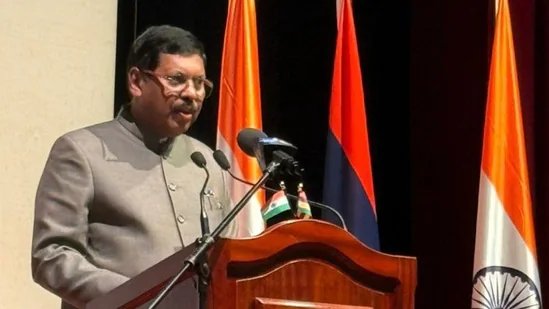Chief Justice BR Gavai Raises Concerns Over Misrepresentation of Judicial Remarks on Social Media
In a recent statement, Chief Justice of India (CJI) BR Gavai highlighted the troubling trend of misrepresentation of judicial remarks on social media platforms. This concern was voiced during a court session following a dramatic incident where a lawyer attempted to throw a shoe at him, an act that underscores the growing tensions surrounding judicial discourse in India.
Context of the Incident
The incident occurred on Monday when Rakesh Kishore, an elderly lawyer, expressed his discontent with CJI Gavai’s comments regarding the restoration of a Lord Vishnu idol at the Khajuraho complex in Madhya Pradesh. The CJI had previously dismissed a plea related to this matter, labeling it as “publicity interest litigation.” His remarks, which suggested that devotees should pray rather than seek judicial intervention, sparked outrage among some members of the legal community and the public.
As Kishore attempted to hurl a shoe at the CJI, security personnel swiftly intervened, escorting him out of the courtroom. CJI Gavai, maintaining his composure, urged court officials to disregard the incident, stating, “Don’t get distracted by all this. We are not distracted. These things do not affect me.” His calm demeanor in the face of provocation reflects a broader commitment to maintaining judicial decorum amidst rising tensions.
The Role of Social Media in Judicial Discourse
CJI Gavai’s remarks about the misrepresentation of judicial comments on social media are particularly relevant in today’s digital age. The rapid dissemination of information, often devoid of context, can lead to significant misunderstandings. During the same court session, he recounted an instance where he had to intervene to prevent his colleague, Justice K Vinod Chandran, from making comments that could be misinterpreted online. “I requested my learned brother to restrict it only to my ears,” he noted, emphasizing the need for caution in judicial discourse.
This incident raises important questions about the relationship between the judiciary and social media. Historically, the judiciary has been seen as a bastion of impartiality and reasoned judgment. However, the rise of social media has introduced a new dynamic, where judicial remarks can be taken out of context and sensationalized, potentially undermining public trust in the legal system.
Judicial Independence and Public Perception
The incident involving the shoe-throwing lawyer is not an isolated case but rather part of a larger narrative concerning the independence of the judiciary in India. The judiciary has faced increasing scrutiny and criticism, particularly in politically charged cases. The CJI’s comments reflect a growing concern among judicial leaders about how public perception can be shaped by social media narratives.
In a country where the judiciary is often viewed as the last line of defense for individual rights, maintaining public confidence is crucial. The CJI’s assertion that he respects all religions, following the backlash from his earlier comments, underscores the delicate balance judges must strike between upholding the law and addressing public sentiment.
Historical Context of Judicial Challenges in India
The challenges faced by the Indian judiciary are not new. Historically, the judiciary has navigated complex socio-political landscapes, often finding itself at odds with public opinion and political pressures. The Emergency period in the 1970s, for instance, saw significant curtailments of judicial independence, leading to a long-lasting impact on public trust in the legal system.
In recent years, the judiciary has been called upon to adjudicate on a range of contentious issues, from religious disputes to civil rights. The Supreme Court’s decisions on matters such as the Ayodhya land dispute and the decriminalization of homosexuality have drawn both praise and criticism, illustrating the judiciary’s pivotal role in shaping societal norms.
The Need for Responsible Discourse
As the digital landscape continues to evolve, the need for responsible discourse becomes increasingly important. CJI Gavai’s concerns about the misrepresentation of judicial remarks serve as a reminder of the potential consequences of unchecked social media narratives. The judiciary must find ways to engage with the public while safeguarding its integrity and independence.
Legal experts suggest that greater transparency and communication from the judiciary could help mitigate misunderstandings. Initiatives such as public outreach programs and educational campaigns about the judicial process may foster a more informed public, reducing the likelihood of misinterpretation.
Conclusion
The recent incident involving Chief Justice BR Gavai and the subsequent concerns he raised about social media misrepresentation highlight the complex interplay between the judiciary and public perception in contemporary India. As the legal landscape continues to evolve, it is imperative for both the judiciary and the public to engage in responsible discourse that respects the rule of law while acknowledging the diverse perspectives within society. The judiciary’s ability to maintain its independence and public trust will be crucial in navigating the challenges of the digital age.











